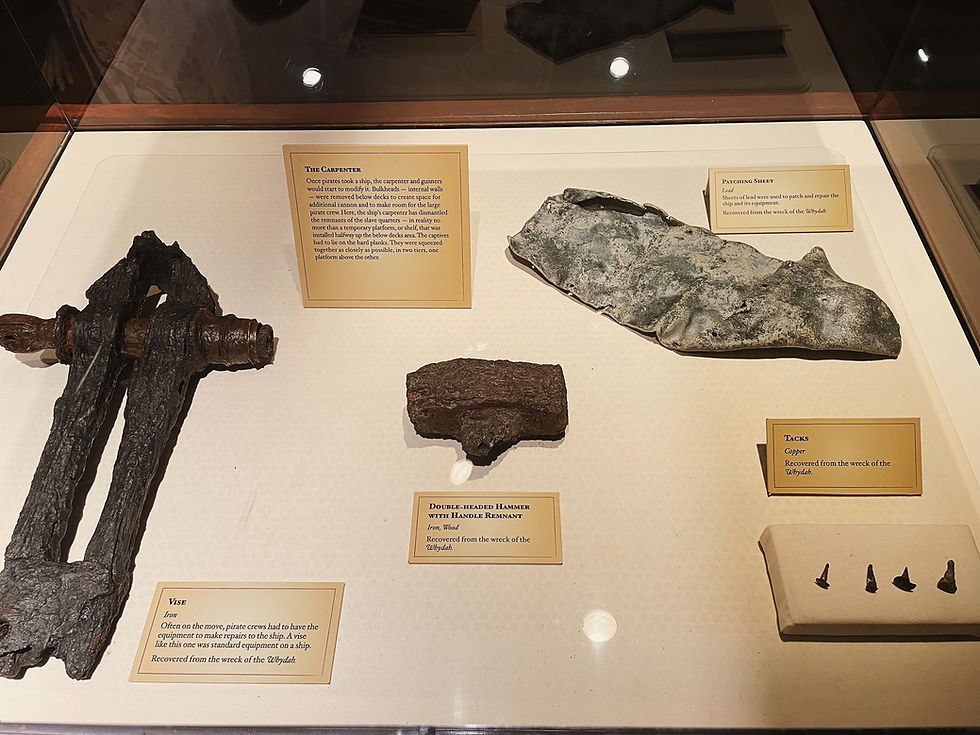"Another Tool Classification" (Burglar's Tools)
- marcsitkin
- Apr 30, 2020
- 3 min read
Updated: May 11, 2023

Left - Burglar tools - Museum of Crime. Middle - Jimmies and Skeleton Keys. Right - Sectional Jimmies. At the top is the carrying case.
By Harry Baer Reprinted from The Chronicle, Volume XVII, No. 3, September 1964
We are all normally accustomed to thinking of tools as implements wholly beneficial to man's welfare. Unfortunately, this is ndt always true. Tools used for a positive purpose have been, and can be, used for a negative purpose. It may, therefore, be of some interest to collectors to re-examine their more peculiar looking tools with a view towards fitting them into another possible category of use. By doing so, they may, perhaps, understand the puzzling design of some tools and may even be able to classify those which are distinctly "whatsit" in character. We are, in fact, suggesting that there may be those who are the innocent possessors of old-time burglars' tools.
Although no dates are available as to the period when various types of burglars' tools were used, we have reason to believe that some of the "offbeat" tools pictured in the engraving go back to approximately 1850, when combination safe locks were first introduced. We say this because combination locks presented problems which the criminal, in the beginning, had to overcome by plain force. Lack of a key to duplicate and a keyhole to "pick" did not thwart him. Except for the "Raffles" type of criminal, who, as fiction would have us believe, could open any combination lock, the practical, hardworking old-time crook did not care to spend too much time swirling a combination lock.
The safe crackers, bank robbers and burglars of yesteryear often displayed remarkable mechanical ability not only in adapting and modifying time-tested tools for their illegal activities, but also in devising ingenious special purpose implements. Although the ancient crook had to procure his tools by devious methods, almost any blacksmith was available to make tools if it was within his capacity to construct them – with no questions asked. As a rule, however, the making of such implements was confined to mechanics who were actually involved with the criminals.

Burglars' Drag, an improved safe-opener. Burglars' tools used to obtain leverage.
A basic problem confronting the burglar then, as now, was the need to construct his tools with an eye towards portability. While he could overcome this aspect of design to a reasonable degree, the heavy weights he had to carry must certainly have made him a very tired man at the end o.f a night's work.
One type of tool peculiar only to the burglar's trade was the sectional "jimmie," a most important device for forcing entry by powerful mechanical leverage. Here a coupling or couplings joined the pieces which were assembled as needed on the job. Wrecking the bank's or merchant's safe required first the use of a drill to make a small opening, after which the safe door was sprung with the "jimmie," until the door hinges broke. Steel wedges pounded into the spaces around the safe door, widening the spaces until the "jimmie" could be inserted, also accomplished the same purpose as a drilled hole, but created more noise. Silence was indeed golden.
If the "jimmie " and the wedge were ineffectual, one of several types of apparatus was brought into play. The jackscrew or "drag," simple as it looked, was extremely powerful and very quiet to operate. In this case, after the hole was drilled, the bent end or filed shoulder was hooked into place on the inside ledge of the hole and the screw turned by a long handle. It was a power that few old-time safes could withstand.

The more reckless of the safe robbers, of course, used explosives, but the patient, careful craftsmen preferred the noiseless method of wrecking the safe with tools – noiseless, that is, except for his grunts of exertion.
While the tools illustrated are mere curiosities of a bygone age, collectors possessing such implements should avoid carrying them about in a bank on a dark night.




Today, the same battle between security and intrusion continues, but in a far more advanced form. Instead of mechanical safes, criminals now face digital systems, vehicle immobilizers, and sophisticated access controls. This is where modern security solutions, such as chip keys & programming, play a vital role—offering layers of protection that require specialized knowledge and authorized tools to bypass. Just as history shows, security evolves, but so do the methods to overcome it, making continuous innovation essential.